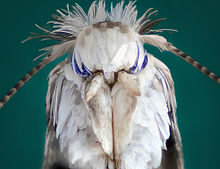Moths
| Moth | |
|---|---|
 |
|
| Closeup of a common clothes moth. | |
| Scientific classification | |
| Kingdom: | Animalia |
| Phylum: | Arthropoda |
| Class: | Insecta |
| Order: | Lepidoptera |
| (unranked): | Heterocera |
Moths comprise a group of insects related to butterflies, belonging to the order Lepidoptera. Most lepidopterans are moths; and there are thought to be approximately 160,000 species of moth, many of which are yet to be described. Most species of moth are nocturnal, but there are also crepuscular and diurnal species.
While the butterflies form a monophyletic group, the moths, comprising the rest of the Lepidoptera, do not. Many attempts have been made to group the superfamilies of the Lepidoptera into natural groups, most of which fail because one of the two groups is not monophyletic: Microlepidoptera and Macrolepidoptera, Heterocera and Rhopalocera, Jugatae and Frenatae, Monotrysia and Ditrysia.
Although the rules for distinguishing moths from butterflies are not hard and fast, one very good guiding principle is that butterflies have thin antennae and (with the exception of the Hedylidae Family) have small balls or clubs at the end of their antennae. Moth antennae can be quite varied in appearance, but in particular lack the club end. The divisions are named by this principle: "club-antennae" (Rhopalocera) or "varied-antennae" (Heterocera).
The modern English word "moth" comes from Old English "moððe" (cf. Northumbrian "mohðe") from Common Germanic (compare Old Norse "motti", Dutch "mot", and German "motte" all meaning "moth"). Its origins are possibly related to the Old English "maða" meaning "maggot" or from the root of "midge" which until the sixteenth century was used mostly to indicate the larva, usually in reference to devouring clothes.
...
Wikipedia
